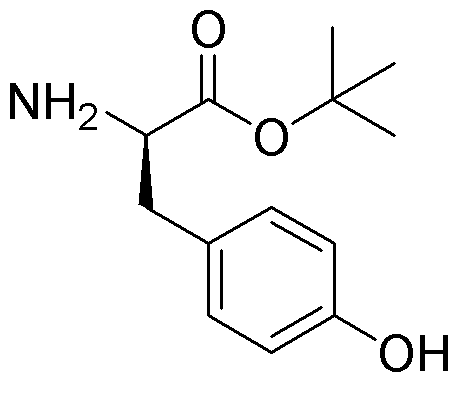D-Tyrosine tert-butyl ester is widely utilized in research focused on
- Pharmaceutical Development: This compound serves as a precursor in synthesizing various pharmaceuticals, particularly those targeting neurological disorders, enhancing drug efficacy and bioavailability.
- Peptide Synthesis: It is commonly used in solid-phase peptide synthesis, allowing for the efficient production of peptides with improved stability and solubility compared to other amino acid derivatives.
- Biochemical Research: Researchers employ it in studies related to protein interactions and enzyme activity, providing insights into metabolic pathways and potential therapeutic targets.
- Cosmetic Formulations: The compound is incorporated into skincare products due to its antioxidant properties, helping to protect skin cells from oxidative stress and improve overall skin health.
- Food Industry: It is used as a flavor enhancer and nutritional supplement, particularly in protein-rich products, contributing to better taste and nutritional profiles.
General Information
Properties
Safety and Regulations
Applications
D-Tyrosine tert-butyl ester is widely utilized in research focused on
- Pharmaceutical Development: This compound serves as a precursor in synthesizing various pharmaceuticals, particularly those targeting neurological disorders, enhancing drug efficacy and bioavailability.
- Peptide Synthesis: It is commonly used in solid-phase peptide synthesis, allowing for the efficient production of peptides with improved stability and solubility compared to other amino acid derivatives.
- Biochemical Research: Researchers employ it in studies related to protein interactions and enzyme activity, providing insights into metabolic pathways and potential therapeutic targets.
- Cosmetic Formulations: The compound is incorporated into skincare products due to its antioxidant properties, helping to protect skin cells from oxidative stress and improve overall skin health.
- Food Industry: It is used as a flavor enhancer and nutritional supplement, particularly in protein-rich products, contributing to better taste and nutritional profiles.
Documents
Safety Data Sheets (SDS)
The SDS provides comprehensive safety information on handling, storage, and disposal of the product.
Product Specification (PS)
The PS provides a comprehensive breakdown of the product’s properties, including chemical composition, physical state, purity, and storage requirements. It also details acceptable quality ranges and the product's intended applications.
Certificates of Analysis (COA)
Search for Certificates of Analysis (COA) by entering the products Lot Number. Lot and Batch Numbers can be found on a product’s label following the words ‘Lot’ or ‘Batch’.
Numéro de catalogue
Numéro de lot/série
Certificates Of Origin (COO)
This COO confirms the country where the product was manufactured, and also details the materials and components used in it and whether it is derived from natural, synthetic, or other specific sources. This certificate may be required for customs, trade, and regulatory compliance.
Numéro de catalogue
Numéro de lot/série
Safety Data Sheets (SDS)
The SDS provides comprehensive safety information on handling, storage, and disposal of the product.
DownloadProduct Specification (PS)
The PS provides a comprehensive breakdown of the product’s properties, including chemical composition, physical state, purity, and storage requirements. It also details acceptable quality ranges and the product's intended applications.
DownloadCertificates of Analysis (COA)
Search for Certificates of Analysis (COA) by entering the products Lot Number. Lot and Batch Numbers can be found on a product’s label following the words ‘Lot’ or ‘Batch’.
Numéro de catalogue
Numéro de lot/série
Certificates Of Origin (COO)
This COO confirms the country where the product was manufactured, and also details the materials and components used in it and whether it is derived from natural, synthetic, or other specific sources. This certificate may be required for customs, trade, and regulatory compliance.


